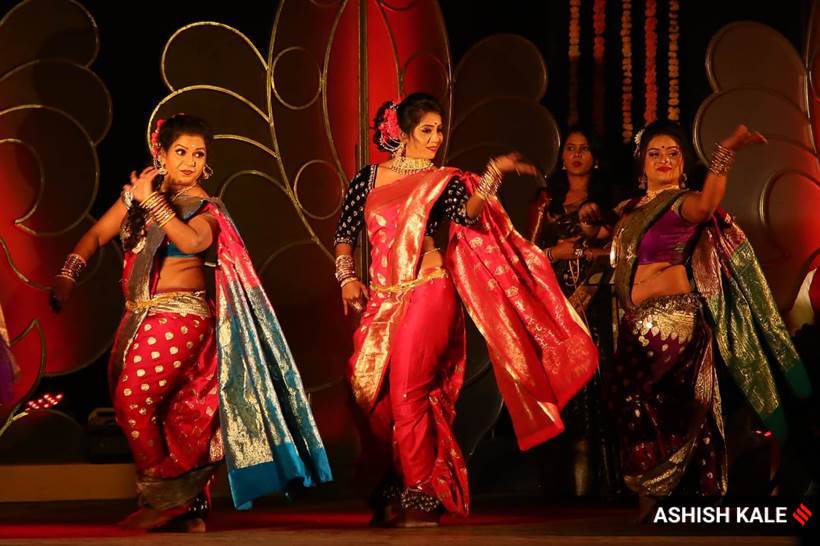

There are also men that dance in lavni along with the ladies. The Lavani poet out-steps the limits of social decency and control when it comes to the depiction of sexual passion." K. Married wife's menstruation, sexual union between husband and Wife, their love, soldier's amorous exploits, the wife's bidding farewell to the husband who is going to join the war, pangs of separation, adulterous love - the intensity of adulterous passion, childbirth: these are all the different themes of the Lavani. "The main subject matter of the Lavani is the love between man and woman in various forms. The sari is wrapped and is more comfortable as compared to other sari types. They usually put a large bindi of dark red color on their forehead. They wear heavy jewellery that includes Thushi means necklace, Bormaal, Pohehaar, Zumka means earrings, Ghungru, kamarpatta (a belt at the waist), bangles, Sindoor etc. They form a bun (juda in Hindi or ambada in marathi) with their hair. The ladies that perform lavani wear a long sari length around 9 yards. The songs were written in sexually explicit double meaning. Notebly it is a kind of Mujra strictly performed for men and away from the village with no access for ladies or families to watch. And, when the Lavani is sung in a closed chamber for a private and select audience by a girl sitting before the audience, it came to be known as Baithakichi Lavani. The Lavani sung and enacted in a public performance before a large audience in a theatrical atmosphere is called Phadachi Lavani. Lavani developed into two distinct performances, namely Phadachi Lavani and Baithakichi Lavani. The devotional music of the Nirguni cult is popular all over Malwa. The Nirguni Lavani (philosophical) and the Shringari Lavani (sensual) are the two types. It is believed their origin is in the Prakrit Gathas collected by Hala. Lavani Songs, which are sung along with dance, are usually naughty and erotic in nature. Originally, it was used as a form of entertainment and morale booster to the tired soldiers. The songs in 'Lavani' are mostly erotic in sentiment and the dialogues tend to be pungent in socio-political satire. Traditionally, this genre of folk dance deals with different and varied subject matters such as society, religion and politics. Lavani dance was generally performed by Dhangars or Shepherd living in the Solapur, Maharashtra.

Lavani dancers were patronised by Maratha Lords and Kings. Lavani dance originated from Maharashtra in 18th and 19th century. Before the dance they gave us the introduction about lavani which included its origin, importance, traditionality and importance so through the performance we felt connected to the marathi culture.Lady performing Lavani dance Origin.We got to learn about the Marathi rhythms and their traditional dance moves.The songs selected for the performance were all melodious and had soulful Marathi rhythm.The students who performed lavani were all well synchronized throughout their performance.These men dance in support with the lead dancer. They are the called nat(male dancer) usually the kinnars. The sari is Wrapped beautifully and is much more comfortable as compared to other sari types. They usually put a large bindi of dark red colour on their forehead. They wear heavy jewellery that includes necklace, earrings, payal, kamarpatta(a belt at waist),bangles etc. The ladies that perform lavani wear a long sari length around 9 metres. The songs in ‘Lavani’ are mostly erotic in sentiment and the dialogues tend to be pungent in socio-political satire.Originally, it was used as a form of entertainment and morale booster to the tired soldiers. Traditionally, this genre of folk dance deals with different and varied subject matters such as society, religion, politics and romance. In Maharashtra and southern Madhya Pradesh and North Karnataka, it is performed by the female performers wearing nine-yard long saris. Lavani has contributed substantially to the development of Marathi folk theatre. Lavani is a combination of traditional song and dance, which particularly performed to the beats of Dholki, a percussion instrument. Lavani is a genre of music popular in Maharashtra. Performed on- 26 th January 2016 INTRODUCTION


 0 kommentar(er)
0 kommentar(er)
